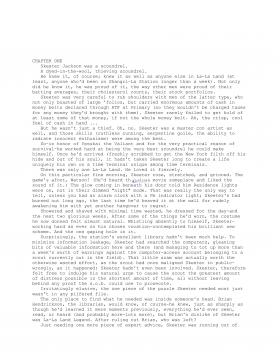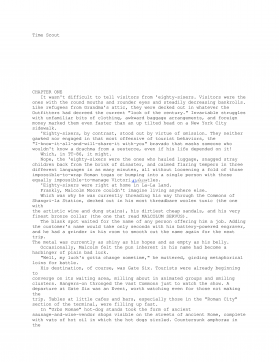
have to keep reminding myself of what I looked like, bringing back the same thoughts I had on that day, and
mold myself accordingly. I mustn’t let the form go, no matter what the Sleepers send. He’s counting on me.”
“Oh,” said Juele, letting out a little breath. So everyone acted as models and teachers—so how did one
tell who was a student and who wasn’t? How very confusing. She meant to straighten that out at once. She
was here to get an education, not just teach what she knew. “Er, who is Peppardine? A teacher?”
Rutaro looked at her as if she had just asked who the Sleepers were. “He is my friend,” Rutaro said at
last. “A fellow student. And a brilliant artist, as you will find out.”
“I’m sorry,” Juele said. Rutaro waved away her apology.
“Never mind. This is the Main Quadrangle,” he said, holding out his hand to encompass the wide green
park surrounded by buildings. Flowers of glorious red and yellow bloomed in artfully arranged beds at the
corners of the square. A few trees, venerable and lovely, rose from the perfectly manicured lawn. On a few
gray stone benches arranged around the perimeter and in a ring at the center of the garden where four paths
intersected, men and women sat or lay. A few were just enjoying the sun. Some of them had sketch pads on
their laps. Others had easels or pedestals and were capturing the beauty of the day in small ways. Juele
caught sight of a perfect miniature model of the main building forming between the hands of a man with
white hair and a creased face. Something in it wasn’t quite right, and the man frowned at it from several
angles, trying to see what was wrong. Juele knew that kind of concentration. Becoming impatient with his
creation, the man waved his arms, exerting his own strength of will, and the building itself changed. Now,
model and work matched perfectly. Here, Life imitated Art.
The buildings, like the gardens, were very beautiful. Juele squinted at them in the bright light, wondering
if she could tell how they had altered under the influence. Yes, she could. The bricks were longer and
thinner, and the lintels of the doors had swan-neck finials on top instead of fan windows. All was still
beautiful and in satisfying proportion, with color and texture that was attractive to the eye. The Sleepers
certainly favored this place. The last time an influence like that came through her home of Wandering, the
whole town square had turned into ramshackle hovels, much to the embarrassment of the town council, who
were having a market fair at the time, with a hundred visitors from out of town. Here, it felt as if nothing
could be ugly, ever. Then, across the square, Juele noticed a man step out through a section of wall as if it
was a door. Behind him she could see a brief glimpse of a corridor and a flight of stairs.
“Oh yes, some of it is illusory, to correct the asymmetry of the real building underneath, and preserve the
beauty of the scene,” Rutaro said, smiling at her surprise.
“Well, why not?” said Juele, with spirit. “How much of this is natural and how much has been altered by
the people here?”
“Well, sometimes the School does it by itself, much in the way a Sleeper maintains the flavor of a
province. The place has an overmind of its own. It has a taste for beauty.”
“Oh,” Juele said. She knew inanimate objects frequently achieved a kind of awareness, even activity. Any
foundation in operation for such a number of years might well create its own ambiance. And it was an art
school. Why, after all, should form interfere with aesthetic enjoyment?
“So what is real, and what’s not?” she asked, eager to understand her new surroundings.
“Does it matter?” Rutaro asked, suddenly bored. He started walking again. Juele grasped her bags and
hurried along the gravel path after him. Had she made an error on her very first day?
“I suppose not,” she said, apologetically. Rutaro waved his fingers, but kept going. The matter was
unimportant and was already forgotten.
I like it here, she thought, looking about at the bright colors and happy bustle. All around her, work was -
going on, questions were being asked, deep conversations were deepening, art was being brought into
existence, and all in conscious pursuit of the greatest beauty. Fabulous. She wondered when she might be
able to start talking with people, and deepening her own understanding.
For two years, Juele had been working on a style of illusion that she found meaningful. She hoped it
would be thought original. All by herself, she had ruthlessly excised from her small images all traces of
anyone else’s style that she detected, keeping the techniques that gave the effect she liked. There hadn’t been
much left at the end, leaving her images spare, but what was there was all hers. She called it “askance
reality.” It had cynicism, but appreciation in it and was really best viewed out of the corner of one’s eye.
Perhaps her style could use some more refining before she brought it up in such sophisticated surroundings.
She opened her mouth to ask, but of its own will her jaw dropped agape, leaving her tongue hanging.
They passed under a narrow stone arch that stretched like a bridge between two upper-story doors. In the
vast square beyond it was one of the most beautiful fountains that she had ever seen. The tiered, pink marble
basins were shallow, and the rims encrusted with pearls and jewels rose in shell-like scallops, the water
lapping diamond-bright between them. The foaming jets of spray leaped up twenty, thirty feet, playing on
the air as gracefully as winged dancers. Around it, eight or ten students were modeling or drawing.
Out of a door to Juele’s right, a woman in a long, blue smock and a preoccupied hurry emerged, walking
straight toward the fountain. Juele lifted a hand to her mouth and started to call out a warning to her, but the
woman ran slap through the middle of the spray, and came out without a drop on her smock. Oh! Juele
thought, letting her hand drop. It was an illusion.
“That fountain is so real!” she said, wonderingly, when she could find her voice. “But it isn’t!”

 2024-12-08 12
2024-12-08 12
 2024-12-08 14
2024-12-08 14
 2024-12-08 10
2024-12-08 10
 2024-12-08 10
2024-12-08 10
 2024-12-08 15
2024-12-08 15
 2024-12-08 18
2024-12-08 18
 2024-12-08 27
2024-12-08 27
 2024-12-08 25
2024-12-08 25
 2024-12-08 16
2024-12-08 16
 2024-12-08 30
2024-12-08 30








 渝公网安备50010702506394
渝公网安备50010702506394
